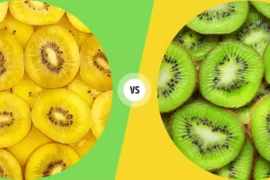When you search about the importance of vitamin C, I know you can find many resources about it. The best source to get vitamin C naturally is fruits. I know the first one that comes to your mind is citric fruit, like orange, lemon, etc. But do you know that kiwifruit contains vitamin C double that of an orange? Also, it contains potassium as much as a banana. Then let’s go to the bottom, looking one by one at the interesting facts about the kiwi fruit. I assure you there is more that you don’t know about kiwi.
Kiwi fruit originated in china.
Usually, came into mind kiwifruit is associated with New Zealand. But it originated in china and is recorded in ancient books 2000 years ago. It is commonly known as Chinese gooseberry. So what’s the point of the kiwi name?
In 1904 a female teacher named Isabel Fraser brought kiwifruit seeds from china to New Zealand. Those seeds germinated there, and after many generations, they became the kiwifruit we currently eat. Furthermore, New Zealand became the largest exporter of kiwifruit, and in 1959 the beautiful Chinese gooseberry was officially named “kiwifruit” after New Zealand’s national symbol, the kiwi bird.
The Kiwi plant is a vine.
From a scientific point of view, kiwifruit is a large vine, like grapes, passion fruit, and other fruit crops. But we are using the term “kiwifruit tree” in actual production. In fact, to grow kiwi fruit you need to frame or mesh to support the vine. It produces fruits for up to 30 years and lives around 50 years.
For a sweeter taste, eat red and yellow kiwis.
The green kiwifruit has a slightly sour taste. If you want to eat sweet kiwifruit, eat red and yellow varieties. The reason is they have high soluble sugar content and low acid content. You can feel a softer taste of yellow and red kiwifruit than green ones. Moreover, kiwifruit’s glycemic index (GI) is about 38 to 52. That is pretty low GI fruit. Even diabetic patients also can enjoy the sweet taste of kiwifruit.
![Interesting Facts About Kiwi Fruit [Bet You Don't Know Many] 1 Kiwi fruit facts](https://www.stethostalk.com/wp-content/uploads/2022/11/Kiwi-fruit-facts.webp)
You can eat kiwi peel.
Most nutrients of kiwi are concentrated in the kiwi skin. You can use a brush to clean the hairs on the kiwi skin. Then you can eat kiwi with skin just like kiwi berries. The kiwifruit peel is rich in phenolic antioxidants, and it can prevent cancer, treat insomnia, and promote gastrointestinal digestion and cleansing. Most of the juice, jam, and candid fruit made from kiwifruits are not thrown away its skin.
Kiwi fruit can use as a meat tenderizer.
In addition to being a healthy fruit, kiwi fruit can use as a meat tenderizer. Actinidin, contained in kiwi, is an enzyme that can dissolve proteins. This enzyme marinates meats. When you use kiwi as a meat tenderizer, please consider allergic reactions. If you can’t eat kiwi because of an allergic reaction, you can use normal meat-tenderizing marinades, such as papaya, salt, and even mallet meat tenderizers.
The dietary fiber content of kiwi fruit is twice that of pineapple.
Every 100 grams of kiwi fruit contains 2.6g of dietary fiber. That is about twice that of pineapple. Kiwi fruit contains both soluble and insoluble dietary fibers. Insoluble dietary fiber promotes defecation, prevents and relieves constipation, removes waste in the body, and promotes the growth of beneficial bacteria in the intestine. Soluble dietary fiber can promote intestinal peristalsis and can delay the intestinal absorption of sugar and lipid.
Kiwi fruit can use as a mask.
Kiwi mask has the effects of cleansing, moisturizing, and whitening. Vitamin C in kiwi can effectively inhibit the oxidation of nutrients in the skin, prevent pigmentation, and effectively whiten and remove freckles. You can use kiwi fruit to make a mask, but don’t use it daily. If you use kiwi fruit as a mask every day, the high acidity of it is not good for the skin. So you can make a mask occasionally.
Kiwi fruit improves sleep.
Kiwi fruit can improve sleep because its rich in various antioxidants and high serotonin. Several studies have shown that low levels of antioxidants in the body can lead to poor sleep. Nutrients such as vitamin C contained in kiwi fruit have antioxidant properties. That is effective in treating a cardiovascular disease associated with sleep apnea.
In addition, kiwi fruit is rich in serotonin, which is also a neurotransmitter. Studies have shown that low serotonin is closely related to depression and mood disorders. It also directly affects sleep. Therefore eating kiwi fruit can improve sleep.
![Interesting Facts About Kiwi Fruit [Bet You Don't Know Many] 2 Facts about kiwi fruit](https://www.stethostalk.com/wp-content/uploads/2022/11/Facts-about-kiwi-fruit.webp)
Kiwi is a dioecious plant.
Dioecious means the single plant has either male or female reproductive organs. Other type is monoecious plants that have both male and female reproductive organs. For successful pollination of kiwi fruit, the male and female plants must be grown close to each other. Pollination occurs by bees or insects. You can also do it manually by spreading pollen on female plants.
Some people are allergic to kiwifruit.
Kiwi fruit contains heterogeneous proteases, and some people with allergies may have an immune reaction, which may lead to allergies. Furthermore, the fluff in kiwi fruit skin may also cause allergic symptoms in people who are allergic to hair. In the case of kiwi allergy, you may experience rash, itching, cough, shortness of breath, abdominal pain, or diarrhea. So you should pay attention to these symptoms and seek medical treatments.

![Interesting Facts About Kiwi Fruit [Bet You Don’t Know Many] Interesting facts about kiwi fruit](https://www.stethostalk.com/wp-content/uploads/2022/11/Interesting-facts-about-kiwi-fruit-1170x508.webp)




![Raspberry Wine Benefits [Top 10] Raspberry wine benefits](https://www.stethostalk.com/wp-content/uploads/2022/12/Raspberry-wine-benefits-270x180.webp)
